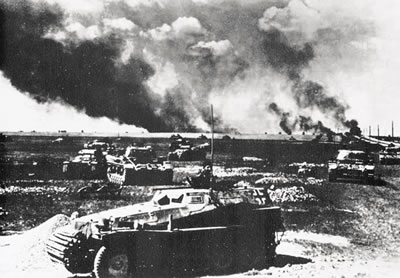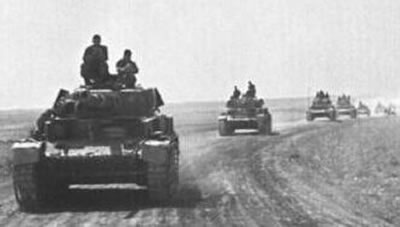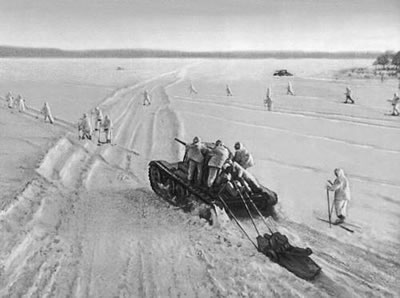Operation Barbarossa was the German campaign to invade the Soviet Union during World War II.
Hitler wanted to kill or enslave the people of Russia, and then use Russia to provide more living space for the German people, whom he considered the superior race.
Operation Barbarossa commenced on June 22, 1941, when Axis forces began advancing toward the USSR. There were 183 Axis troop divisions, containing about 3 ½ million men, as well as about 350 Axis tanks.
 The German tanks that were used during Operation Barbarossa included PzKpfw IIs, IIIs, IVs, 35(t)s, and 38(t)s, as well as some captured tanks.
The German tanks that were used during Operation Barbarossa included PzKpfw IIs, IIIs, IVs, 35(t)s, and 38(t)s, as well as some captured tanks.
By this time, German tank warfare was more advanced than it had ever been before.
Realizing that they had to move quickly, and that towing a gun behind a vehicle would slow them down, the Germans were using self-propelled artillery, such as the sIG33 self-propelled howitzer. This was an infantry-support howitzer that was placed on top of the chassis of a PzKpfw I. A three-sided light armored shield protected the crew.
The Soviets had a much larger tank force, consisting of at least 22,000 tanks. However, when operation Barbarossa began, many of these tanks were inferior to the German tanks. Some of these inferior Soviet tanks were T-27 tankettes, T-26 light tanks and T-28 medium tanks.
In addition, the Soviets also had BT-5 and BT-7 tank medium tanks. These had good mobility and were well armed, but their armor was not thick of enough to act as an effective defense against the German panzers.
The most effective tanks that the Soviets had were KV-1 heavy tanks and T-34 medium tanks, which However, the Soviets only had a small number of these tanks.
The KV-1 had excellent firepower and extremely thick armor. The only way the Germans could stop a KV-1 was by destroying its tracks.
However, the KV-1 often suffered from mechanical failure and was difficult to drive.
The T-34, which had a new Christie suspension, was a better tank than the KV-1. It had excellent mobility, as well as thick armor and powerful weapons.
Early Stages of Operation Barbarossa
During the first weeks of Operation Barbarossa, the Germans were able to get past Soviet forces and then move east, up to the Volga River.
German plans were for three separate Army Groups to move in different directions. Army Group North was to move toward Leningrad, while Army Group Center would advance toward Byelorussia. Once Army Group North had taken Leningrad, the two Army Groups would then converge and move on toward Moscow.
 Meanwhile, Army Group South would advance toward Kiev.
Meanwhile, Army Group South would advance toward Kiev.
When the Germans first invaded, the Soviets were in a difficult position. They did not have reserves. Soviet troops were not allowed to take up defensive positions, so many Soviet units were caught when they were moving or when they were trying to establish positions.
In addition, many experienced Soviet military officers had been executed during Stalin’s Great Purge. These officers had been replaced by officers with less experience.
By July 3, 1941, the Soviet Byelorussian Group, commanded by Marshal Semyon Timoshenko had been defeated by Germany’s Army Group Center. Nearly 300,000 men were taken prisoner. More than 2,500 tanks and almost 1,500 artillery pieces were lost.
Meanwhile, Army Group North had already crossed the Dvina River and Army Group South had crossed the River Bug.
Battle of Smolensk
Army Group Center then moved on to capture Smolensk. By August 5, Smolensk had fallen to the Germans, who took 185,000 prisoners. The Soviets lost more than 2,000 artillery pieces and more than 2,000 tanks.
Siege of Leningrad
Hitler then decided to redeploy some of Army Group Center’s armored forces. Some of the forces that were originally supposed to move on to Moscow were sent north to help with the attack on Leningrad, while others were sent south to aid in the advance toward Kiev.
By September 8, 1941, the Germans had surrounded Leningrad, cutting off all supplies to the city.
However, the Germans were never able to capture Leningrad.
Battle of Kiev
German troops were able to encircle Kiev.
By September 1941, the Soviet Ukrainian Group had surrendered. This time, the Germans were able to capture 650,000 prisoners, 900 tanks and 3,700 artillery pieces.
 Battle of Moscow
Battle of Moscow
With German forces unable to take Leningrad, Hitler decided to resume the advance on Moscow.
The campaign to capture Moscow was given the name Operation Typhoon.
German panzers, with the aid of German airpower, advanced toward Moscow, encircling the cities of Vyazma and Bryansk. By October 1941, Axis forces had captured more than 650,000 prisoners, more than 5,400 artillery pieces and more than 1,200 tanks.
At this time of year, however, western Russia was plagued with heavy rainfall. The roads became covering the roads with mud. German troops were stalled until November, when the mud froze.
The Germans then moved on toward Moscow. However, it was now winter, and the Germans were not adequately prepared for the cold.
German equipment began to malfunction, and German soldiers began dying form frostbite and hypothermia.
The Germans were forced to retreat to their forward supply bases, in order to protect themselves from the cold.
The Soviets, commanded by Marshal Georgi Zhukov commenced a counterattack on December 5, 1941. A neutrality agreement with Japan had freed up troops from Siberia, and these were now deployed against the Germans.
By now, hundreds of new T-34 medium tanks were available to Soviet troops. An important advantage of the T-34 tank was that it could easily be mass-produced.
It was almost impossible for German weapons to stop a T-34.
German soldiers had already been demoralized by the cold. Now, they were discovering that the Soviets, who previously had inferior tanks, now had tanks that were superior to any German tanks and could not be defeated by German anti-tank weapons.
In fact, the Germans were so impressed by the T-34 that they copied it later on. The German version of the T-34 became the Panther (PzKpfw V).
Soviet forces performed a flanking operation, trapping the German troops and forcing them further back.
By the end of 1941, operation Barbarossa had proven to be a failure. The Germans failed to achieve their goal of conquering Russia.
However, the Siege of Leningrad continued until 1944. More than one million civilians are believed to have died during the Siege of Leningrad, many of them from starvation.